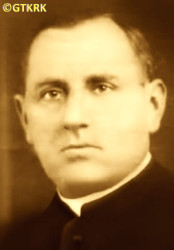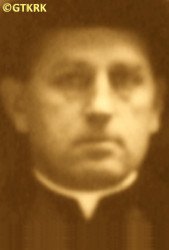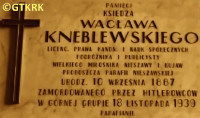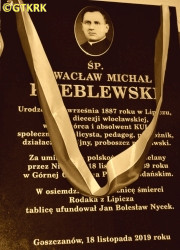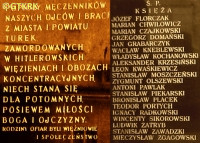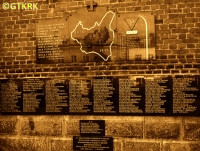Roman Catholic
St Sigismund parish
05-507 Słomczyn
85 Wiślana Str.
Konstancin deanery
Warsaw archdiocese, Poland
full list:
displayClick to display full list

searchClick to search full list by categories
wyświetlKliknij by wyświetlić pełną listę po polsku

szukajKliknij by przeszukać listę wg kategorii po polsku

Martyrology of the clergy — Poland
XX century (1914 – 1989)
personal data
surname
KNEBLEWSKI
forename(s)
Vaclav Michael (pl. Wacław Michał)
function
diocesan priest
creed
Latin (Roman Catholic) Church RCmore on
en.wikipedia.org
[access: 2014.09.21]
diocese / province
Włocławek diocesemore on
en.wikipedia.org
[access: 2013.05.19]
Włocławek i.e. Kalisz diocesemore on
pl.wikipedia.org
[access: 2019.10.13]
academic distinctions
Bachelor of Canon Law and Social Sciences
honorary titles
Order of the Crown (Yugoslavia) — 3rd Class Commandermore on
en.wikipedia.org
[access: 2020.09.18]
(1931)
„Gen. Haller's Sword” badgemore on
pl.wikipedia.org
[access: 2025.08.19]
date and place
of death
18.11.1939

Mniszek ‐ Grupa foresttoday: Dragacz gm., Świecie pov., Kuyavia‐Pomerania voiv., Poland
more on
en.wikipedia.org
[access: 2021.12.18]
alt. dates and places
of death
Górna Grupatoday: Dragacz gm., Świecie pov., Kuyavia‐Pomerania voiv., Poland
more on
en.wikipedia.org
[access: 2021.09.02]
details of death
As a student, in 1919‐1920, during the Polish–Russian War of 1919‐1921, chaplain of Military Hospital No. 3 in Lublin.
After German and Russian invasion of Poland in 09.1939 (Russians invaded Poland 17 days later) and start of the World War II attempted to reach, with thousands of refugees, Warsaw — prob. to hand in collected funds for Yugoslavia in their Warsaw embassy.
Failed to do so after a genocidal aerial bombing raid by German planes of civilian targets in Jabłonna.
After start of German occupation returned to his parish.
Warned about an impending arrest remained in his parish.
On 21.10.1939 arrested by the Germans together with clergy from his deanery.
Jailed in Aleksandrów Kujawski's prison.
Next transported to Fort VII (Toruń) concentration camp.
From there on 04.11.1939 moved to VSH Schwetz camp in Świecie, prob. to f. mentally ill Institute patients of which had already been exterminated by that time.
Two day later on 06.11.1939 driven to DL Ober Gruppe transit camp in Górna Grupa.
Finally taken to a place of execution and murdered.
The arrests and genocidal murders — in a forest complex c. 15 km long and 10 km wide, near the villages of Mniszek (on the site of a former gravel pit) and Grupa (on the site of a former Polish military training ground), c. 16 km north‐east of Świecie and c. 10 km west of Grudziądz, located on the other side of the Vistula River — were carried out as part of the Germ. «Intelligenzaktion» (Eng. „Intelligence Action”), i.e. the extermination of the Polish intelligentsia and the leadership classes of Pomerania, mainly by the genocidal units of the Germ. Volksdeutscher Selbstschutz (Eng Self‐Defense of Ethnic Germans), whose members were Germ. Volksdeutsche (Eng. Ethnic Germans), i.e. representatives of the German minority in Poland from Świecie and the surrounding area. They were supervised by members of the paramilitary, genocidal Germ. Die Schutzstaffel der NSDAP (Eng. NSDAP Protection Squad), i.e. «SS», subordinate to the National Socialist German Workers' Party NSDAP.
The selection of sentenced to death — from among arrested on the basis of the one of the so‐called Germ. Sonderfahndungsliste (Eng. Special Wanted List), i.e. a proscription list of names of „enemies of the Reich”, prepared before the German aggression, or on some other proscription list, drawn up ad hoc, compiled based on denunciations from local Germ. Volksdeutsche — was made by the so‐called Germ. Volksgericht (Eng. People's Court), which included a dozen or so local Germ. Volksdeutsche.
The signal to begin the genocide was given by the Germ. Gauleiter (Eng. District Governor) of the NSDAP in Gdańsk, later Germ. Reichsstatthalter (Eng. Reich Governor) of the newly established occupation province of the Germ. Reichsgau Danzig–Westpreußen (Eng. Reich Gdańsk–West Prussia District), Albert Maria Forster, who in Świecie called on all local Germans to strictly follow the orders, adding: „even if they had to bathe in blood up to their necks”.
The victims — held at the VSH Schwetz detention center in Świecie, the prison in Grudziądz, the internment camp in Nowe on Vistula, and the DL Ober Gruppe transit camp set up at the Divine Word Missionaries SVD Congregation's house in Górna Grupa, where they were subjected to harassment and torture — were transported to the crime scene in columns of c. 5‐10 trucks and buses, driven and escorted by soldiers of the Germ. Wehrmacht (Eng. Armed Forces).
Executions took place on average every three days, sometimes involving as many as three victim shipments per day. The murders, under the glare of car headlights, generally lasted from 18:00 to midnight. The victims were herded into previously dug pits and murdered by shots to the back of the head or by machine gun fire.
Those who showed signs of life were finished off with shovels, sticks, and rifle butts. Some were buried alive. Those who tried to resist were hanged on makeshift gallows.
A special group of victims were the patients of the Psychiatric Hospital in Świecie. From the Hospital, as part of the genocidal program «Aktion T4», i.e. Germ. „Vernichtung von lebensunwertem Leben” (Eng. „elimination of life not worth living”), they were taken to the execution site in groups of two buses that could accommodate c. 50 people, and the murders were carried out by the Germ. SS‐Wachsturmbann „Eimann” (Eng. Guard and Assault Unit „Eimann”), established by the decree of the Senate of the Free City of Gdańsk on 03.07.1939, formed on the basis of the 36. SS‐Standarte (Eng. 36th SS Propaganda Unit) from Gdańsk, which had the character of, among other things, a military band, itself part of «SS».
From 10.1939 till c. 04.1940, the Germans murdered c. 10,000 Poles there, including c. 1,350 patients of the aforementioned Psychiatric Hospital in Świecie. Among the latter were 120 children who were taken to execution under the guise of going on a trip. Dr Joseph Bednarz, the director of the Hospital, was also murdered along with the patients, choosing to remain with the patients entrusted to him until the end.
At the end of the war, in 1944/1945, due to the approaching German–Russian front, as part of the Germ. „Sonderaktion 1005” (Eng. „Special Action 1005”) — using groups of prisoners, mainly Russian POWs, known as Germ. „Leichenkommandos” (Eng. „Corpse Units”) — the Germans dug up most of the bodies and then burned them.
When in 1946, after the German defeat and the end of military operations in World War II, an exhumation was carried out, a 150‐meter‐long pit was discovered in the forests described, filled with fragments of partially burned human remains, bones and objects belonging to the murdered.
cause of death
mass murder
perpetrators
Germans
sites and events
Mniszek / Grupa forestClick to display the description, DL Ober GruppeClick to display the description, Świecie (Institute)Click to display the description, VSH SchwetzClick to display the description, IL Fort VII ThornClick to display the description, Piaski (Aleksandrów Kujawski)Click to display the description, «Intelligenzaktion»Click to display the description, Reichsgau Danzig‐WestpreußenClick to display the description, Ribbentrop‐MolotovClick to display the description, Pius XI's encyclicalsClick to display the description
date and place
of birth
22.09.1887Birth certification on:
photos.szukajwarchiwach.gov.pl
[access: 2025.04.13]

Lipiczetoday: Goszczanów gm., Sieradz pov., Łódź voiv., Poland
more on
pl.wikipedia.org
[access: 2021.12.18]
parents
KNEBLEWSKI Louis
🞲 ?, ? — 🕆 ?, ?

BOGDAŃSKA Valentina
🞲 ?, ? — 🕆 ?, ?
baptism
09.10.1887Birth certification on:
photos.szukajwarchiwach.gov.pl
[access: 2025.04.13]

Goszczanówtoday: Goszczanów gm., Sieradz pov., Łódź voiv., Poland
more on
en.wikipedia.org
[access: 2020.12.16]
St Martin the Bishop and Confessor and St Stanislav the Bishop and Martyr RC church
presbyter (holy orders)
ordination
12.06.1910

Włocławektoday: Włocławek city pov., Kuyavia‐Pomerania voiv., Poland
more on
en.wikipedia.org
[access: 2021.12.18]
Assumption of the Blessed Virgin Mary RC cathedral churchmore on
en.wikipedia.org
[access: 2025.03.14]
positions held
1932 – 1939
parish priest — Nieszawatoday: Nieszawa gm., Aleksandrów Kujawski pov., Kuyavia‐Pomerania voiv., Poland
more on
en.wikipedia.org
[access: 2020.11.05] ⋄ St Hedwig of Silesia RC parish ⋄ Nieszawatoday: Nieszawa gm., Aleksandrów Kujawski pov., Kuyavia‐Pomerania voiv., Poland
more on
en.wikipedia.org
[access: 2020.11.05] RC deanery
c. 1928 – 1932
resident — Warsawtoday: Warsaw city pov., Masovia voiv., Poland
more on
en.wikipedia.org
[access: 2021.10.09] — employee of the Catholic Press Agency KAP; also: founder of the League of Polish–Yugoslav Associations (1931), organizer of the Polish–Yugoslav friendship congress in Poznań (26.04.1931), editor‐in‐chief of the „Polish–Yugoslav Yearly” published by the League of Polish–Yugoslav Associations in Warsaw
c. 1928
missionary — (Yugoslavia territory)more on
en.wikipedia.org
[access: 2023.11.24] ⋄ Polish parishes — among Polish economic emigrants, mainly from the beginning of XX century; also: Polish delegate at the site of the earthquake in the southern part of that country (prob. on 14.02.1927 in Bosnia and Herzegovina)
1925 – c. 1927
resident — Włocławektoday: Włocławek city pov., Kuyavia‐Pomerania voiv., Poland
more on
en.wikipedia.org
[access: 2021.12.18] ⋄ St Stanislav the Bishop and Martyr RC parish ⋄ Włocławektoday: Włocławek city pov., Kuyavia‐Pomerania voiv., Poland
more on
en.wikipedia.org
[access: 2021.12.18] RC deanery — i.a. editor of the „Kuyavia Word” daily
1922 – 1925
fundraiser — (United States of America territory)today: United States of America
more on
en.wikipedia.org
[access: 2022.08.05] — envoy of the rector and grand chancellor of the Catholic University of Lublin KUL, fundraising for KUL and the so‐called Holy Cross barracks, designated for the seat of KUL — i.a. in 29 Polish parishes on the east coast of the USA, in the states of New York US‐NY, Pennsylvania US‐PA, New Jersey US‐NJ and Connecticut US‐CT (e.g. in Brooklyn US‐NY, Newark US‐NJ, Elmhurst US‐NY, Passaic US‐NJ, Buffalo US‐NY, Staten Island US‐NY, New Britain US‐CT), as well as Chicago US‐IL and Milwaukee US‐WI
1925
organizer — Detroittoday: Wayne Cou., Michigan US‐MI state, United States of America
more on
en.wikipedia.org
[access: 2022.08.05] ⋄ Congress of Polish Emigration — The congress was held on 21‐23.04.1925; earlier: head of the Central Pre–Congress Office
c. 1924 – 1925
PhD student — Washingtontoday: District of Columbia US‐DC state, United States of America
more on
en.wikipedia.org
[access: 2022.07.21] ⋄ Canon Law Section, Department of Theology, Catholic University of America
1919 – 1922
student — Lublintoday: Lublin city pov., Lublin voiv., Poland
more on
en.wikipedia.org
[access: 2021.08.20] ⋄ Department of Canon Law and Moral Sciences, Catholic University of Lublin KUL [i.e. Catholic University of Lublin KUL (since 1928) / clandestine Catholic University of Lublin KUL (1939‐1944) / University of Lublin (1918‐1928)] — postgraduate specialised studies, crowned on 07.06.1922 with the title of Bachelor of Canon Law and Moral Sciences; also: in 1919‐1920, during the Polish–Russian War of 1919‐1921, chaplain of the military hospital No. 3 and educational officer at the District Hospital in Lublin
1920 – 1921
fundraiser — (United States of America territory)today: United States of America
more on
en.wikipedia.org
[access: 2022.08.05] — envoy of the rector and grand chancellor of the Catholic University of Lublin KUL (episcopal and university delegate), fundraising for the newly established university — i.a. in Chicago US‐IL, Milwaukee US‐WI, South Milwaukee US‐WI, Syracuse US‐NY, Detroit US‐MI, Philadelphia US‐PA, Buffalo US‐NY, Los Angeles US‐CA, Syracuse US‐NY, Green Bay US‐WI, St Louis US‐MO, Omaha US‐NE, Kansas City US‐MI and US‐KS, San Francisco US‐CA, Minneapolis US‐MN, St Paul US‐MN , South Bend US‐IN, Ramsey US‐NJ (Salesian institute), Pulaski US‐WI (Conventual Franciscans OFMConv); also: lecturer (on situation in Poland — regaining independence, Polish–Ukrainian war, Polish–Russian war)
1913 – 1919
resident — Częstochowatoday: Częstochowa city pov., Silesia voiv., Poland
more on
en.wikipedia.org
[access: 2021.12.18] ⋄ St Barbara the Virgin and Martyr RC parish ⋄ Częstochowatoday: Częstochowa city pov., Silesia voiv., Poland
more on
en.wikipedia.org
[access: 2021.12.18] RC deanery — prefect of Ms Tekla Busz's Gymnasium for Girls (c. 1917‐1919) and Ms Chrzanowska's Gymnasium for Women; also: chaplain of the nursing home and St Casimir orphanage, lecturer of Polish history at the courses for illiterate organized by the School Care Society, scouting inspector and member of the board of the Częstochowa Care Council
1912 – 1913
vicar — Rakówtoday: district of Częstochowa, Częstochowa city pov., Silesia voiv., Poland
more on
en.wikipedia.org
[access: 2021.12.18] ⋄ Our Lady of the Rosary RC chapel ⋄ St Joseph the Craftsman RC parish ⋄ Częstochowatoday: Częstochowa city pov., Silesia voiv., Poland
more on
en.wikipedia.org
[access: 2021.12.18] RC deanery
1911 – 1912
vicar — Uniejówtoday: Uniejów gm., Poddębice pov., Łódź voiv., Poland
more on
en.wikipedia.org
[access: 2021.12.18] ⋄ Assumption of the Blessed Virgin Mary RC church ⋄ St Florian RC parish ⋄ Turektoday: Turek gm., Turek pov., Greater Poland voiv., Poland
more on
en.wikipedia.org
[access: 2020.12.11] RC deanery
1910 – 1911
vicar — Kramsktoday: Kramsk gm., Konin pov., Greater Poland voiv., Poland
more on
en.wikipedia.org
[access: 2020.12.16] ⋄ St Stanislav the Bishop and Martyr RC parish ⋄ Konintoday: Konin city pov., Greater Poland voiv., Poland
more on
en.wikipedia.org
[access: 2021.12.19] RC deanery
1904 – 1910
student — Włocławektoday: Włocławek city pov., Kuyavia‐Pomerania voiv., Poland
more on
en.wikipedia.org
[access: 2021.12.18] ⋄ philosophy and theology, Theological Seminary
editor — of „Kuyavia Courier”, „National Courier” in the USA (till 1924), „Częstochowa Kurier”
publicist, author of books, incl. „Upbringing and school” (1912), „Pedagogical sketches” (1917), „From the Polish Baltic Sea: a tourist sketch” (1920), „At the sources of the holy river: sketches from a trip through Palestine” (1934), „Religious face of Yugoslavia” (1933), „Catholic Action in Slovenia” (1934), „In the rays of the cult of Queen Hedwig”; also: poet
others related
in death
BERTELClick to display biography Ceslav, BORUCKIClick to display biography, BRZÓSKOWSKIClick to display biography Vladislav, BURDYNClick to display biography Bernard Frederick, BUSSClick to display biography Casimir, CZOGAŁAClick to display biography Ignatius, ZNANIECKIClick to display biography Sebastian Martin Paul, ECHAUSTClick to display biography Bruno, HOŁUBOWSKIClick to display biography Bonaventure, JAKUBIAKClick to display biography Boleslav, KOTEWICZClick to display biography Stanislav, KOWALClick to display biography Henry Stanislav, KUCZYŃSKIClick to display biography Marian, MAKOWSKIClick to display biography Roman, MALORNYClick to display biography Francis, MAŃKIEWICZClick to display biography Henry, MEGGERClick to display biography Vladislav, MIKUCZEWSKIClick to display biography Louis, NODZYŃSKIClick to display biography Andrew, PEŁKAClick to display biography Leo Alphonse, REPIŃSKIClick to display biography Sigismund Louis, ROGALSKIClick to display biography John, SOŁTYSIAKClick to display biography John, WALECKIClick to display biography Vaclav, WOJTASZEWSKIClick to display biography Casimir, ŻUKOWSKIClick to display biography Vincent, BOKClick to display biography Francis, KĄDZIELAClick to display biography Alphonse, SZYBOWSKIClick to display biography Francis, ZIELIŃSKIClick to display biography Heliodorus
sites and events
descriptions
Mniszek / Grupa forest: From 10.1939 till c. 04.1940 in the complex of forests by villages of Mniszek (in a former gravel mine) and Grupa (on the former Polish military training ground), c. 16 km to the north‐east of Świecie and c. 10 km to the west of Grudziądz, Germans murdered in mass executions approx. 10,000 Poles, brought from prison in Świecie (as VSH Schwetz custody), from Psychiatric Hospital in Świecie (c. 1,000 patients — the patients were brought in parties 60‐strong, having been given sedatives prior to dispatch), prison in Grudziądz, internment camp in Nowe on Vistula, from Divine Word Missionaries SVD missionary house in Górna Grupa — mainly intelligentsia, from Świecie, Bydgoszcz, Chełmno, Grudziądz and Starogard Gdański counties in Pomerania. Among the victims were c. 120 children brought out under a school trip guise. Murders were perpetrated by Germans from Volksdeutscher Selbstschutz and SS genocidal organisations. Wehrmacht soldiers served as truck drivers. The victims were being killed of with shovels, sticks, sometimes buried alive. Those who attempted to defend themselves were hung. In 1944 Germand dug out most of the bodies and burnt them. (more on: groby.radaopwim.gov.plClick to attempt to display webpage
[access: 2013.01.13], pl.wikipedia.orgClick to attempt to display webpage
[access: 2021.12.19])
DL Ober Gruppe: From 10.1939 till c. 04.1940, in the Divine Word Missionaries SVD Congregation's house in Górna Grupa — taken over by the Germans after the suspension of the activities of the Minor Seminary run by the friars, and their internment, and the repurposing of the building for military purposes — the Germans organized a Germ. Durchgangslager (Eng. Transit camp), i.e. DL Ober Gruppe, for Poles, including 95 Polish clergy, from the Świecie, Bydgoszcz, Chełmno, Grudziądz, and Starogard Gdański regions in Pomerania. C. 50 of them — detained as part of the Germ. «Intelligenzaktion» (Eng. „Action Intelligence”), i.e. the extermination of the Polish intelligentsia and leadership classes in Pomerania — perished, a significant number of them murdered at the execution sites in Mniszek‐Grupa. In the same place in 1945 Russians set up a concentration camp for Germans, among whom two priests perished. (more on: pl.wikipedia.orgClick to attempt to display webpage
[access: 2021.12.19], www.kpbc.ukw.edu.plClick to attempt to display webpage
[access: 2013.12.27])
Świecie (Institute): In the autumn of 1939 Germans— as part of «Aktion T4» program — murdered almost all patients of the National Pomeranian Psychiatric Institute in Świecie. On 15‐21.10.1939 c. 1,000 patients were murdered in the forest by Mniszek village, in groups of 60. Among the victims were 120 children. And hospital’s Polish director, Joseph Bednarz PhD, who stayed with his patients till the end. The victims were pushed — three aside — into specially prepared ditches and shot by the members of the genocidal German SS‐Wachsturmbann „Eimann” unit from machine guns. C. 300 patients were transported to Kocborowo psychiatric hospital and murdered later in Szpęgawsk forest. (more on: ipn.gov.plClick to attempt to display webpage
[access: 2015.05.09])
VSH Schwetz: German Germ. Volksdeutscher Selbstschutzhaft (Eng. Volksdeutscher Selbstschutz custody) VSH founded in 09.1939 by the genocidal German paramilitary organization Volksdeutscher Selbstschutz in Świecie nad Wisłą. The decision to create Selbstschutz in the Polish lands occupied by German troops was made in Berlin on 08‐10.09.1939 at a conference headed by Reichsführer‐SS Heinrich Himmler (the formal order bears the date 20.09.1939), and the chaotically formed units were directly subordinated to the officers of the genocidal SS organization. The Germans captured Świecie on 03.09.1939. As part of the «Intelligenzaktion», i.e. the extermination of Polish intelligentsia and leadership classes, arrests of local Poles began immediately. The victims were imprisoned and held in terrible conditions in the cells of the court prison in Świecie, empty pavilions of the National Pomeranian Psychiatric Institution (especially after 22.10.1939, when the Germans murdered most of its patients as part of «Aktion T4»), distillery buildings in Luszkówko, prison cells in Nowe nad Wisłą and in the buildings of the Divine Word Missionaries institute in Górna Grupa. They were subjected to torture and harassment. From c. 08‐09.10.1939 mass executions began — the day before the first execution in Świecie, the Germ. Gauleiter (Eng. district governor) of the German National Socialist Party NSDAP in Gdańsk, later the Germ. Reichsstatthalter (Eng. Reich Governor) of the Germ. Reichsgau Danzig–Westpreußen (Eng. Reich District Gdańsk–West Prussia), appeared and called on all local Germans to strictly carry out the orders, adding „even if it meant bathing in blood up to the necks” — i.a. at the Jewish cemetery in Świecie, as well as in the forests near the village of Mniszek and the military training ground in the village of Grupa. Dozens of Catholic priests passed through the prison, of whom c. 50 died: 20 were murdered by the Germans in Mniszek, and the rest perished in German concentration camps. (more on: pl.wikipedia.orgClick to attempt to display webpage
[access: 2021.12.19])
IL Fort VII Thorn: Germ. „Internierungslager” (Eng. „Internment camp”) organized by the Germans on c. 15.10.1939 in Toruń, in the Fort VII artillery fort built in the years 1879‐1883 on a pentagonal plan, the last main fort of the Toruń fortress. Initially managed by Wehrmacht soldiers, but on 26.10.1939, taken over by members of the genocidal German paramilitary organization Volksdeutscher Selbstschutz. As part of the «Intelligenzaktion» operation, the extermination of the Polish intelligentsia of Pomerania, Polish citizens of Toruń and the surrounding area, men and women, were detained there. At one time, from 700 to 1,500 people, considered „politically suspect Polish elements”, were held captive — 50‐80 prisoners in each cell intended for 6‐12 people. In total, c. 3,000 Poles were to pass through the camp. Detainees were tortured, physically and mentally. More than 1,500 people were shot in the Barbarka and Przysieka forests. The rest, c. 600 people, were in 01.1940 transported to the KL Stutthof concentration camp. At the end of 01.1940, the camp was moved to nearby Fort VIII, where it operated until 07.1940. (more on: pl.wikipedia.orgClick to attempt to display webpage
[access: 2013.08.10])
Piaski (Aleksandrów Kujawski): In Piaski (today district of Aleksandrów Kujawski) Germans in 10‐11.1939 held in provisional(?) prison priests from Alekandrów Kujawski and Nieszawa deanery, prior to sending them to the Fort VII camp in Toruń. (more on: salezjanie.plClick to attempt to display webpage
[access: 2013.08.31])
«Intelligenzaktion»: German: «Intelligenzaktion» (English: „Intelligence Action”) — a German program of extermination of the Polish elite, mainly the intelligentsia and leadership layers, carried out from the beginning of the occupation in w 09.1939 to 04.1940, mainly in territories directly annexed to Germany, but also in the so‐called Germ. Generalgouvernement (Eng. General Governorate), where it was called «AB‐aktion». In the first phase, immediately after the beginning of the German occupation, during military operations carried out by the Germ. Wehrmacht (Eng. Armed Forces) and the genocidal units of the Germ. Einsatzgruppen (Eng. Operational Groups) of the Germ. Sicherheitspolizei (Eng. Security Police), i.e. SiPo, and Germ. Sicherheitsdienst des Reichsführers SS (Eng. Security Service of the Reichsführer SS), i.e. SD, organized by the Germ. Reichssicherheitshauptamt (Eng. Reich Main Security Office), i.e. RSHA, which followed the troops, carried out under the Germ. Unternehmen „Tannenberg” (Eng. Operation „Tannenberg”) — based on the so‐called Germ. Sonderfahndungsliste (Eng. Special Wanted Lists), i.e. proscription lists of Poles considered particularly dangerous to the Third Reich, prepared by the Zentralstelle II/P (Polen) unit of the German RSHA. Later, implemented by the German civilian occupation authorities and the genocidal unit of the Germ. Volksdeutscher Selbstschutz (Eng. Ethnic Germans Self‐Defense), whose members were Germ. Volksdeutsche (Eng. Ethnic Germans), i.e. representatives of the German minority in Poland. According to various sources, these lists, at the beginning of 09.1939, could have contained the details of 61,000—88,000 „dangerous” Poles — although these figures cannot be confirmed. In total, during this genocide, c. 50,000 teachers, Catholic priests, representatives of the landed gentry, freelancers, social and political activists, and retired military personnel were systematically and methodically murdered. Another 50,000 were sent to concentration camps, where only a negligible percentage survived. (more on: en.wikipedia.orgClick to attempt to display webpage
[access: 2014.10.04])
Reichsgau Danzig‐Westpreußen: After the Polish defeat in the 09.1939 campaign, which was the result of the Ribbentrop‐Molotov Pact and constituted the first stage of World War II, and the beginning of German occupation in part of Poland (in the other, eastern part of Poland, the Russian occupation began), the Germans divided the occupied Polish territory into five main regions (and a few smaller). The largest one was transformed into Germ. Generalgouvernement (Eng. General Governorate), intended exclusively for Poles and Jews and constituting part of the so‐called Germ. Großdeutschland (Eng. Greater Germany). Two were added to existing German provinces. From two other separate new provinces were created. Vistula Pomerania region was one of them, incorporated into Germany on 08.10.1939, by decree of the German leader Adolf Hitler (formally came into force on 26.10.1939), and on 02.11.1939 transformed into the Germ. Reichsgau Danzig‐Westpreußen (Eng. Reich District of Gdańsk‐West Prussia) province, in which the law of the German state was to apply. The main axis of the policy of the new province, the territory of which the Germans recognized as the Germ. „Ursprünglich Deutsche” (Eng. „natively German”), despite the fact that 85% of its inhabitants were Poles, was Germ. „Entpolonisierung” (Eng. „Depolonisation”), i.e. forced Germanization. C. 60,000 Poles were murdered in 1939‐1940, as part of the Germ. „Intelligenzaktion”, i.e. extermination of Polish intelligentsia and ruling classes, in c. 432 places of mass executions — including c. 220 Polish Catholic priests. The same number were sent to German concentration camps, from where few returned (over 300 priests were arrested, of whom c. 130 died in concentration camps). C. 124,000‐170,000 were displaced, including c. 90,000 to the Germ. Generalgouvernement. Poles were forced en masse to sign the German nationality list, the Germ. Deutsche Volksliste DVL. Polish children could only learn in German. It was forbidden to use the Polish language during Catholic Holy Masses and during confession. Polish landed estates were confiscated..To further reduce the number of the Polish population, Poles were sent to forced labor deep inside Germany. The remaining Poles were treated as low‐skilled labor, isolated from the Germans and strictly controlled — legally, three or three of them could only meet together, even in their own apartments. Many were conscripted into the German Wehrmacht army. After the end of hostilities of World War II, the overseer of this province, the Germ. Reichsstatthalter (Eng. Reich Governor) and the Germ. Gauleiter (Eng. district head) of the German National Socialist Party, Albert Maria Forster, was executed. (more on: en.wikipedia.orgClick to attempt to display webpage
[access: 2024.06.24])
Ribbentrop‐Molotov: Genocidal Russian‐German alliance pact between Russian leader Joseph Stalin and German leader Adolf Hitler signed on 23.08.1939 in Moscow by respective foreign ministers, Mr. Vyacheslav Molotov for Russia and Joachim von Ribbentrop for Germany. The pact sanctioned and was the direct cause of joint Russian and German invasion of Poland and the outbreak of the World War II in 09.1939. In a political sense, the pact was an attempt to restore the status quo ante before 1914, with one exception, namely the „commercial” exchange of the so‐called „Kingdom of Poland”, which in 1914 was part of the Russian Empire, fore Eastern Galicia (today's western Ukraine), in 1914 belonging to the Austro‐Hungarian Empire. Galicia, including Lviv, was to be taken over by the Russians, the „Kingdom of Poland” — under the name of the General Governorate — Germany. The resultant „war was one of the greatest calamities and dramas of humanity in history, for two atheistic and anti‐Christian ideologies — national and international socialism — rejected God and His fifth Decalogue commandment: Thou shall not kill!” (Abp Stanislav Gądecki, 01.09.2019). The decisions taken — backed up by the betrayal of the formal allies of Poland, France and Germany, which on 12.09.1939, at a joint conference in Abbeville, decided not to provide aid to attacked Poland and not to take military action against Germany (a clear breach of treaty obligations with Poland) — were on 28.09.1939 slightly altered and made more precise when a treaty on „German‐Russian boundaries and friendship” was agreed by the same murderous signatories. One of its findings was establishment of spheres of influence in Central and Eastern Europe and in consequence IV partition of Poland. In one of its secret annexes agreed, that: „the Signatories will not tolerate on its respective territories any Polish propaganda that affects the territory of the other Side. On their respective territories they will suppress all such propaganda and inform each other of the measures taken to accomplish it”. The agreements resulted in a series of meeting between two genocidal organization representing both sides — German Gestapo and Russian NKVD when coordination of efforts to exterminate Polish intelligentsia and Polish leading classes (in Germany called «Intelligenzaktion», in Russia took the form of Katyń massacres) where discussed. Resulted in deaths of hundreds of thousands of Polish intelligentsia, including thousands of priests presented here, and tens of millions of ordinary people,. The results of this Russian‐German pact lasted till 1989 and are still in evidence even today. (more on: en.wikipedia.orgClick to attempt to display webpage
[access: 2015.09.30])
Pius XI's encyclicals: Facing the creation of two totalitarian systems in Europe, which seemed to compete with each other, though there were more similarities than contradictions between them, Pope Pius XI issued in 03.1937 (within 5 days) two encyclicals. In the „Mit brennender Sorge” (Eng. „With Burning Concern”) published on 14.03.1938, condemned the national socialism prevailing in Germany. The Pope wrote: „Whoever, following the old Germanic‐pre‐Christian beliefs, puts various impersonal fate in the place of a personal God, denies the wisdom of God and Providence […], whoever exalts earthly values: race or nation, or state, or state system, representatives of state power or other fundamental values of human society, […] and makes them the highest standard of all values, including religious ones, and idolizes them, this one […] is far from true faith in God and from a worldview corresponding to such faith”. On 19.03.1937, published „Divini Redemptoris” (Eng. „Divine Redeemer”), in which criticized Russian communism, dialectical materialism and the class struggle theory. The Pope wrote: „Communism deprives man of freedom, and therefore the spiritual basis of all life norms. It deprives the human person of all his dignity and any moral support with which he could resist the onslaught of blind passions […] This is the new gospel that Bolshevik and godless communism preaches as a message of salvation and redemption of humanity”… Pius XI demanded that the established human law be subjected to the natural law of God , recommended the implementation of the ideal of a Christian state and society, and called on Catholics to resist. Two years later, National Socialist Germany and Communist Russia came together and started World War II. (more on: www.vatican.vaClick to attempt to display webpage
[access: 2023.05.28], www.vatican.vaClick to attempt to display webpage
[access: 2023.05.28])
sources
personal:
groby.radaopwim.gov.plClick to attempt to display webpage
[access: 2013.01.13], torun.naszemiasto.plClick to attempt to display webpage
[access: 2013.01.13], www.kul.plClick to attempt to display webpage
[access: 2024.12.13], photos.szukajwarchiwach.gov.plClick to attempt to display webpage
[access: 2025.04.13], perspectiva.plClick to attempt to display webpage
[access: 2013.01.13], ordynariat.wp.mil.plClick to attempt to display webpage
[access: 2024.12.13], pl.wikipedia.orgClick to attempt to display webpage
[access: 2021.12.19]
bibliographical:
„Victims of German crime among Włocławek diocese clergy”, Fr Stanislav Librowski, „Włocławek Diocese Chronicle”, 07‐08.1947
original images:
gloria.tvClick to attempt to display webpage
[access: 2020.09.18], www.archiwumkorporacyjne.plClick to attempt to display webpage
[access: 2020.09.18], billiongraves.comClick to attempt to display webpage
[access: 2020.09.18], www.opiekun.kalisz.plClick to attempt to display webpage
[access: 2020.09.18]
LETTER to CUSTODIAN/ADMINISTRATOR
If you have an Email client on your communicator/computer — such as Mozilla Thunderbird, Windows Mail or Microsoft Outlook, described at WikipediaPatrz:
en.wikipedia.org, among others — try the link below, please:
LETTER to CUSTODIAN/ADMINISTRATORClick and try to call your own Email client
If however you do not run such a client or the above link is not active please send an email to the Custodian/Administrator using your account — in your customary email/correspondence engine — at the following address:

giving the following as the subject:
MARTYROLOGY: KNEBLEWSKI Vaclav Michael
To return to the biography press below:
 Click to return to biography
Click to return to biography








